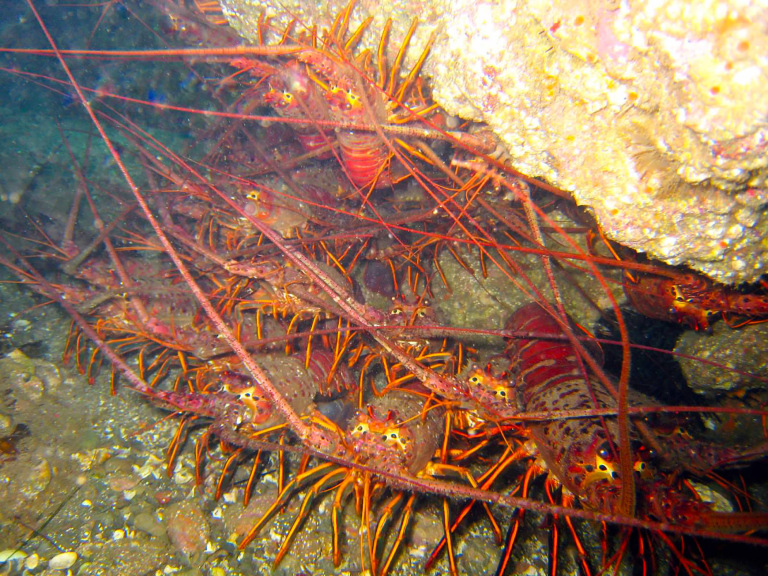Measuring Lobsters the Right Way

by Carrie Wilson
2-9-2018
Website
Question: I jumped on an open party lobster trip recently (their counts were high!). The crew members were measuring while all of us were watching up close. The 3 ¼” tool would drop over the carapace and if fairly tight, they claimed it to be a “keeper.” When I politely asked them about this, they were adamant that these were legal bugs. Can you please describe proper measuring at the edge of a lobster’s carapace? Can the tool drop in over the carapace edge, and if tight, is a legal bug? (Jim Kelley)
Answer: The crew members were correct – an accurate measuring gauge should fit tightly in a straight line measurement on the lobster carapace from the rear edge of the eye socket to the rear edge of the body shell. When the lobster gauge is placed on the carapace, there should be no space at all between the gauge and the carapace. Please make sure the part of the gauge that is placed on the rear edge of the eye socket is on the hard part of the shell, not on the soft fleshy part where the eyes are. If there is any gap at all between the lobster carapace and the gauge, no matter how small, the lobster is too short and a citation could be issued. See California Code of Regulations Title 14, section 29.90(c) for specific language.
Can I Use My Drone as a Jig?
Question: I have a drone that is set up for fishing. I have a Cannon downrigger quick-release that I can attach to my drone. I would like to use my drone to troll or as a jig. When the fish strikes, the line would be pulled free from the drone, and I would fight and retrieve the fish with my rod and reel. Is that legal? (James K.)
Answer: Under existing law, using a drone to jig tackle that remains connected to your rod and reel is not illegal so long as the drone is being legally flown in a legal area. Recognizing that regulations on drones are becoming tighter, especially in sensitive areas, you need to be familiar with all local ordinances or special jurisdictions as well. The U.S. Fish and Wildlife Service has issued citations to drone operators for “harassing wildlife” in some areas of the state, so use common sense when flying and be aware of your fellow anglers.
Can I Have a Restaurant Prepare my Ducks?
Question: Duck season just ended and although the last weekend was slow due to the unseasonably warm weather, the prior two weekends were good. I would like to take several friends to a restaurant where they will prepare my own ducks for us to eat. I have heard this is legal to do but I don’t know what the requirements are to stay within the law. (Jake M., Sacramento)
Answer: Fish and Game Code, section 2015 provides the legal authorization and requirements. Although it is generally unlawful to possess a bird, mammal, fish, amphibian, or reptile, that may not be legally sold, in a restaurant or other eating establishment, there are specific exceptions that would apply in your situation.
Those exceptions include: (1) A person who lawfully took or otherwise legally possessed the bird, mammal, fish, amphibian or reptile, (2) a person preparing the bird, mammal, fish, amphibian or reptile for consumption by the person who lawfully took or possessed it, or by that person and others, if the person who took or possessed it is present on the premises. or (3) A bird, mammal, fish, amphibian or reptile tagged with a signed statement from the person who took the bird, mammal, fish, amphibian or reptile. The statement must include that person’s name and address, the date it was taken and the total number and kind taken.
You can enjoy your duck dinner at your favorite restaurant with your friends.
Hunting From a Float Tube Between California and Arizona
Question: Is it legal to hunt from a float tube for ducks and geese in Blythe? (Anonymous)
Answer: Yes, during the season, you can hunt from a float tube for ducks and geese in Blythe, but you must mind where the state boundary is within the river so that you do not float into Arizona with unlawfully taken birds. There are some places where you may be on what appears to be the California side of the river while you are actually standing in Arizona. The belt-and-suspenders approach is to buy both a California resident hunting license and an Arizona non-resident hunting license, with each respective state duck stamp, and the federal migratory bird stamp.
Carrie Wilson is a marine environmental scientist with the California Department of Fish and Wildlife. While she cannot personally answer everyone’s questions, she will select a few to answer each week in this column. Please contact her at CalOutdoors@wildlife.ca.gov.
More Reports

2-9-2018
California anglers interested in the recreational Pacific halibut fishery are invited to provide input to the California Department of Fish...... Read More

2-8-2018
The California Department of Fish and Wildlife (CDFW) today announced the selection of 38 projects that will receive funding for...... Read More
